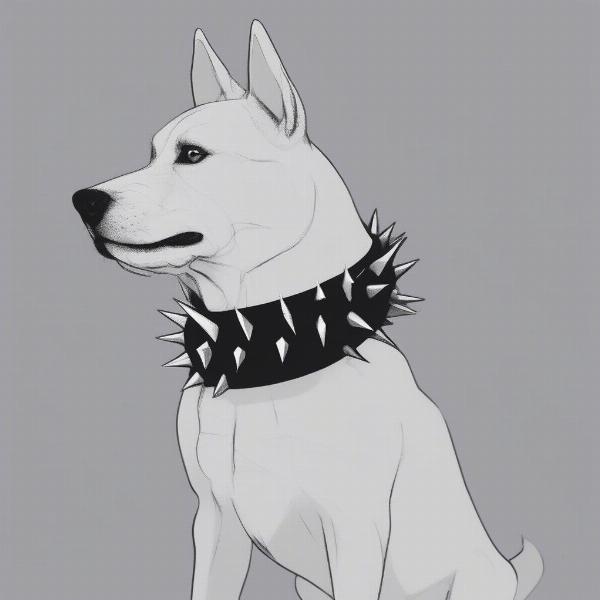Spiky dog collars are a popular choice for many pet owners, offering both a stylish look and potential practical benefits. But are they right for your dog? This comprehensive guide explores everything you need to know about spiky dog collars, from their history and various types to their safety and proper usage. We’ll delve into the pros and cons, address common concerns, and provide expert insights to help you make an informed decision for your furry friend.
History and Evolution of Spiky Dog Collars
Originally, spiked dog collars served a practical purpose. Centuries ago, working dogs and livestock guardians wore them for protection against predators, especially wolves. The spikes, often made of metal, acted as a defense mechanism, deterring attacks to the neck and throat. Over time, these functional collars evolved, becoming more of a fashion statement than a protective necessity. Today, spiky collars are available in a wide range of materials, styles, and designs, catering to diverse aesthetic preferences.
Types of Spiky Dog Collars
Modern spiky dog collars come in various materials like leather, nylon, and even vegan options. The spikes themselves can be metal, plastic, or rubber, offering different levels of durability and aesthetics. Some popular types include:
- Traditional Leather Collars: Often featuring robust metal spikes, these collars provide a classic and rugged look.
- Nylon Collars with Plastic Spikes: A lighter and more affordable option, these collars are ideal for everyday wear.
- Studded Collars: These collars offer a less intimidating look with smaller, rounded studs.
- Designer Spiky Collars: For fashion-forward pups, these collars incorporate unique designs and embellishments.
Are Spiky Dog Collars Safe?
The safety of spiky dog collars is a frequently debated topic. While they can look intimidating, responsible use is key. Collars that are too tight can cause discomfort or even injury, while overly sharp spikes can pose a risk to both the dog and other animals. Here are some safety considerations:
- Proper Fit: Ensure the collar fits snugly but allows two fingers to fit comfortably between the collar and your dog’s neck.
- Spike Material and Sharpness: Opt for blunt or rounded spikes, especially for playful dogs or those housed with other pets.
- Supervision: Always supervise your dog while wearing a spiky collar, particularly during interactions with other animals.
Training and Behavioral Considerations
While a spiky collar might look tough, it shouldn’t be used as a training tool. Positive reinforcement methods are always more effective and humane. Using a spiky collar for aversive training can lead to fear, aggression, and other behavioral problems. Instead, focus on rewarding desired behaviors and building a positive relationship with your dog.
 Dog Wearing a Spiky Collar Safely
Dog Wearing a Spiky Collar Safely
Choosing the Right Spiky Collar for Your Dog
Selecting the appropriate spiky collar involves considering your dog’s size, breed, activity level, and the intended purpose of the collar. For smaller breeds, lighter collars with smaller spikes are recommended. For larger, more active breeds, a durable collar with sturdy spikes might be more suitable.
Conclusion
Spiky dog collars can be a stylish and, in some cases, practical accessory for your canine companion. However, responsible usage, proper fit, and prioritizing your dog’s safety and well-being are paramount. By considering the factors outlined in this guide and choosing wisely, you can ensure your dog rocks their spiky collar with both style and safety. Always remember, a well-fitted collar and responsible ownership are key to a happy and healthy dog.
FAQ
- Are spiky collars cruel? Not necessarily, but improper use can be. A properly fitted collar with blunt spikes used responsibly shouldn’t cause harm.
- Can my dog sleep in a spiky collar? It’s generally not recommended. Remove the collar at night to prevent potential entanglement or discomfort.
- Are there any alternatives to spiky collars? Yes, there are many other collar types available, including flat collars, martingale collars, and harnesses.
- Can I use a spiky collar for training? No, positive reinforcement methods are much more effective and humane for training.
- What if my dog’s spiky collar gets damaged? Replace it immediately to avoid any potential safety hazards.
- Where can I buy a high-quality spiky dog collar? Reputable pet stores and online retailers offer a wide selection.
- How do I clean a spiky dog collar? Cleaning methods depend on the material. Check the manufacturer’s instructions for specific guidance.
ILM Dog is your trusted resource for all things dog-related. We offer expert advice on dog breeds, health, training, nutrition, grooming, and much more. Whether you’re a new dog owner or a seasoned pro, we’re here to help you provide the best possible care for your furry friend. For expert advice on dog collars and other accessories, contact us at [email protected] or call us at +44 20-3965-8624. Visit ILM Dog for more information on dog care and products.